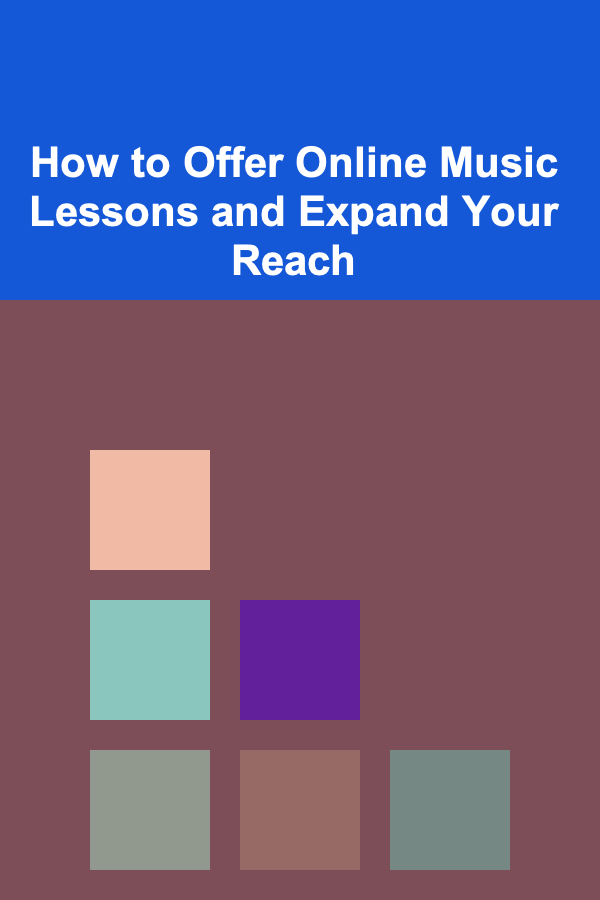
How to Offer Online Music Lessons and Expand Your Reach
ebook include PDF & Audio bundle (Micro Guide)
$12.99$8.99
Limited Time Offer! Order within the next:

In today's digital world, offering online music lessons has become a viable way to connect with students and share your musical expertise. Whether you're an experienced music teacher or a professional musician, transitioning to online teaching can open up new avenues for income and exposure. This comprehensive guide will walk you through the steps of offering online music lessons and effectively expanding your reach, all while ensuring a high-quality learning experience for your students.
Define Your Teaching Niche
The first step in offering online music lessons is to clearly define your niche. Music is an expansive field, and narrowing your focus can help you target the right audience and build a brand around your expertise.
Identify Your Strengths
Reflect on your musical background, experience, and skills. Are you a classical pianist, a jazz saxophonist, or a guitar enthusiast? Your specific strengths will help you choose your niche and appeal to students looking for that expertise.
Consider Popular Music Genres or Instruments
You can choose to specialize in one particular genre (like jazz, classical, rock, or pop) or focus on specific instruments (piano, guitar, violin, etc.). Alternatively, you could also offer lessons in music theory, music production, songwriting, or vocal coaching, depending on your skills.
Actionable Steps:
- Assess your skills and experience: Reflect on your musical background and identify the areas in which you excel.
- Research demand: Use platforms like Google Trends or social media groups to find out what potential students are searching for.
- Create a niche statement: Develop a short, clear message that describes the specific musical services you offer.
Set Up Your Online Teaching Infrastructure
To deliver high-quality online music lessons, you'll need to invest in the right tools and technology. The right setup will ensure that your students have a smooth and enjoyable learning experience.
Essential Equipment for Online Music Lessons
- Camera: A high-quality webcam or DSLR camera is essential for providing a clear and detailed view of your teaching. An HD camera will help students see finger placements and other important details.
- Microphone: Good audio quality is crucial for online music lessons. Invest in a quality microphone (such as a condenser mic or lavalier mic) to capture your voice and instrument clearly.
- Lighting: Proper lighting is important for visibility. Natural light or softbox lights can make a huge difference in how your lessons look.
- Internet Connection: A reliable internet connection is a must. Aim for at least 10 Mbps upload speed to ensure a smooth experience without buffering.
- Music Software: For students who play instruments digitally or for music production lessons, you might need music software like Ableton Live, Logic Pro, or GarageBand.
Platforms for Teaching Music Online
Choosing the right platform for teaching is another key decision. Several online teaching platforms cater specifically to music instructors:
- Zoom: A popular choice for live lessons due to its easy screen sharing and reliable video quality.
- Skype: Another option with video and audio features that are ideal for teaching music.
- Teachable or Thinkific: If you're interested in creating pre-recorded courses, these platforms can help you host and sell your lessons.
- Lessonface: A platform dedicated to music teachers that also allows you to book and manage lessons easily.
Actionable Steps:
- Invest in quality equipment: Purchase a good camera, microphone, and lighting setup.
- Choose a reliable platform: Decide whether you want to offer live lessons (Zoom, Skype) or pre-recorded courses (Teachable, Thinkific).
- Test your setup: Before launching, conduct test lessons to ensure everything works smoothly, including video, audio, and internet connectivity.
Create a Structured Curriculum
A well-organized curriculum is essential for providing a comprehensive and effective learning experience for your students. Whether you're teaching beginners or advanced musicians, a clear structure will ensure that your lessons are focused and productive.
Define Learning Goals
Before you begin creating your lessons, outline the goals you want your students to achieve. Are they learning to play a specific song, improve their technique, or grasp music theory? Knowing your objectives will help guide your lesson planning.
Break Down Lessons by Skill Level
Design your curriculum based on the skill level of your target students:
- Beginner: Focus on basic concepts, simple songs, and foundational techniques.
- Intermediate: Introduce more complex songs, music theory, and improvisation.
- Advanced: Teach advanced techniques, music composition, and performance skills.
Develop Engaging Content
Your curriculum should include a variety of learning materials:
- Video Lessons: Record lessons that explain concepts or demonstrate techniques.
- Practice Exercises: Provide students with assignments and exercises to complete between lessons.
- Sheet Music or Chord Charts: Share sheet music, chord charts, or other written materials for students to practice.
- Feedback and Assessments: Offer constructive feedback to help students improve and track their progress.
Actionable Steps:
- Create lesson outlines: Map out what each lesson will cover and ensure there is a logical progression.
- Diversify your teaching materials: Use a combination of video, written material, and hands-on exercises.
- Plan assessments: Schedule regular check-ins to track progress and offer personalized feedback.
Set Your Pricing Structure
Pricing your online music lessons can be tricky, as it depends on your experience, niche, and target audience. However, it's important to set a fair price that reflects your expertise while remaining accessible to students.
Determine Your Hourly Rate
Research what other music teachers charge for similar lessons. Rates vary based on factors such as:
- Experience: More experienced teachers generally charge higher rates.
- Lesson length: 30-minute, 45-minute, and 60-minute lessons each have different pricing.
- Skill level: Advanced lessons or specialized instruments tend to be priced higher.
Consider Offering Packages
Instead of just offering single lessons, create lesson packages to incentivize longer-term commitment. For example, you could offer a discount for students who book a month's worth of lessons in advance.
Payment Methods
Choose a convenient and secure payment method. Some popular options include PayPal, Stripe, or direct bank transfers. Also, ensure that your payment system is integrated with the lesson scheduling platform for ease of use.
Actionable Steps:
- Research pricing: Look at other music teachers in your niche and area to determine a competitive price.
- Offer discounts for bulk lessons: Encourage students to commit by offering discounts for multiple lessons.
- Set up an easy payment system: Use secure platforms like PayPal or Stripe to collect payments from students.
Promote Your Online Music Lessons
Now that you've set up your infrastructure, curriculum, and pricing, it's time to promote your online music lessons and expand your reach.
Build Your Online Presence
A strong online presence is crucial for attracting new students. Start by building a professional website where you can showcase your credentials, teaching style, testimonials, and lesson offerings. Also, create social media profiles (Facebook, Instagram, LinkedIn) to engage with potential students and share your musical knowledge.
Leverage Content Marketing
Create valuable content to establish yourself as an authority in the music education space. Start a blog, post instructional videos, or offer free resources like sheet music or mini-lessons. This will help you build trust with your audience and attract new students.
Run Paid Ads
Consider running targeted ads on platforms like Facebook or Instagram. These platforms allow you to target specific audiences, such as people interested in learning a particular instrument or genre. Ads can be a cost-effective way to reach a wider audience quickly.
Collaborate with Other Musicians or Schools
Partnering with other music teachers, schools, or music stores can help you expand your reach. You could offer joint lessons, workshops, or events that attract new students.
Actionable Steps:
- Create a professional website: Showcase your expertise, lesson offerings, and testimonials.
- Post regularly on social media: Share your lessons, tips, and behind-the-scenes content.
- Invest in paid ads: Run targeted ads on Facebook and Instagram to attract new students.
- Collaborate: Partner with other musicians or institutions to expand your audience.
Engage with Students and Build a Community
One of the best ways to retain students and expand your reach is by building a strong, engaged community. Students who feel connected to you and other learners are more likely to stay committed to their lessons and refer others to you.
Create a Student Community
Use platforms like Facebook Groups or Discord to create a space where your students can interact with you and each other. You can share practice tips, answer questions, and foster a sense of community.
Offer Ongoing Support
Beyond the lessons themselves, offer ongoing support to your students. Answer their questions, provide extra resources, or offer practice tips between lessons.
Collect Feedback and Improve
Regularly ask for feedback from your students to improve your teaching style and lesson content. This will help you grow as a teacher and maintain a high level of satisfaction among your students.
Actionable Steps:
- Create a student community: Use Facebook or Discord to engage students outside of lessons.
- Offer extra support: Provide ongoing resources and feedback to ensure student success.
- Collect feedback: Use surveys or direct conversations to gather input on how you can improve your lessons.
Conclusion
Offering online music lessons is an excellent way to reach students around the world and build a sustainable business. By focusing on a clear niche, setting up the right technology, creating a structured curriculum, and effectively promoting your lessons, you can create a thriving online teaching practice. With dedication, creativity, and the right tools, you'll be able to share your passion for music while growing your reach and influence in the music education community.

How To Build a Simple E-commerce Site
Read More
How to Create a Holiday-Themed Entryway That Impresses Guests
Read More
How to Develop Resilient Food Systems
Read More
How to Plan a Memorable Home Cocktail Party
Read More
How to Use Rugs and Carpets for Soundproofing Your Floors
Read More
The Impact of Continuing Education on Your Job Search
Read MoreOther Products

How To Build a Simple E-commerce Site
Read More
How to Create a Holiday-Themed Entryway That Impresses Guests
Read More
How to Develop Resilient Food Systems
Read More
How to Plan a Memorable Home Cocktail Party
Read More
How to Use Rugs and Carpets for Soundproofing Your Floors
Read More